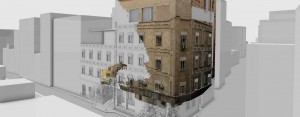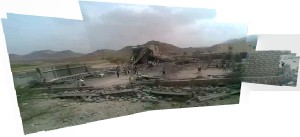An introduction to: Forensic Architecture.
Forensic Architecture (FA) is a research based agency located at Goldsmith’s university, London. It undertakes advanced architectural and media research on behalf on international prosecutors, human rights organizations and political and environmental justice groups. It refers to the production and presentation of architectural evidence – buildings and larger environments and their media representations.
As contemporary conflicts increasingly occur in dense urbanized areas, homes and neighborhoods become targets. Casualties come to be in cities, buildings and the ‘safety’ of their own home. Nowadays, thanks to this multimedia era, urban battlegrounds are overflowing with information and data shared to social media platforms. Many violations, undertaken within cities and buildings, are now caught on camera and are made available almost instantly. The premise of FA is that analyzing IHL and HR violations must involve modelling dynamic events as they unfold in space and time and creating navigable 3D models of environments undergoing conflict, as well as the creation of filmic animations, and interactive cartographics on the urban or architectural scale.
These techniques allow FA to create precise, convincing and accessible information that could be crucial for the pursuit of accountability. Architectural analysis is also important because it enables new insights in context of urban conflicts.
The widespread possession of cheap digital recording equipment, the development of satellite communication, the public availability of remote sensing technology and the ability to communicate and diffuse information instantaneously through the internet have made urban conflict more complex, but also generate enormous amounts of data that can be used as potential resources for monitoring. However, these transformations also lead to secondary conflict about interpretation that takes place on news and social media websites. The establishment of new forums of international jurisdiction mean that also contemporary forums themselves become dense media environments. In them screen-to-screen interaction replaces face-to-face deliberation. The combined process of the urbanization and mediatization of war makes FA an urgent and indispensable practice for human rights investigations. FA seeks to respond to these challenges by developing new modes of media research and new modes of media presentation for urban and architectural environments.
Results of day-to-day technology and modern media.
Nowadays our lives are filled and dependent on electronic devices, and with that I don’t mean ‘the ones that keep you breathing in the hospital’. It is the smartphones, tablets, laptops, smart watches and what not, that makes that we can function in modern society. Because of it we can keep up with the ever-changing world on a speed that we have never seen before. Now it is a very contemporary debate if this is a positive development, many pointing out the negative. From a subjective and personal point of view I would have to place myself on negative end of the spectrum as well, seeing the unfavorable short and long term effects. Finding out about FA was because of that very thought-provoking.
I will open up a research project that compares positive and negative aspects of modern media and technology use in the present-day.
I will introduce this research through a series of set examples.
Generation Selfie
First of all, a negative side to the rise of social media is the deteriorating self image and esteem of essentially Generation Z and the Millennial’s. Quoting scientist Clarissa Silva:
“Social media has been linked to higher levels of loneliness, envy, anxiety, depression, narcissism and decreased social skills. As a Behavioral Scientist, I wonder what causes this paradox? The narratives we share and portray on social media are all positive and celebratory. It’s a hybridized digital version of “Keeping up with the Joneses”. Meaning for some, sometimes it appears everyone you know is in great relationships, taking 5-star vacations and living your dream life. However, what is shared across our social networks only broadcasts the positive aspects of our lives-the highlight reels.”
The idea of saving and sharing the highlights of our lives has been a long past introduced concept, think about the photography albums your parents made of you and themselves. But in this new form of doing so, we are constantly bombarded with other’s excitements and achievements in life as well. From the envy and hate- love relationships we hold with our online society grows a competition with a non-existent finish line. Seeing photos and videos of your ‘friend’s’ beautiful holiday destinations, their new set of clothing and perfect life is just a start. The image we have our own appearance decreases drastically, not only as an indirect result of the examples shown above, but also the obsessive behavior around beauty.
It has been part of mankind that the vision on beauty evolves over time and differs from culture to culture, but the coming of social networks has changed the game thoroughly. We can change our DNA online to look like what we see as perfect. Setting impossible goals for ourselves in real life, which makes it less interesting to ‘live’ there.


Panoptical Society
“He who is subjected to a field of visibility and who knows it, assumes responsibility for the constraints of power; he makes them play spontaneously upon himself; he inscribes in himself the power relation in which he simultaneously plays both roles; he becomes the principle of his own subjection”
A quote from Michel Foucault about ‘Discipline and Punishment’ and his theory of the panopticon, referring to an experimental laboratory of power in which behavior could be modified, he viewed it as a symbol of the disciplinary society of surveillance. Jeremy Bentham proposed the panopticon as a circular building with an observation tower in the center of an open space surrounded by an outer wall. This wall would contain cells for occupants. This design would increase security by facilitating more effective surveillance. Residing within cells flooded with light, occupants would be readily distinguishable and visible to an official invisibly positioned in the central tower. Conversely, occupants would be invisible to each other, with concrete walls dividing their cells. Due to the bright lighting emitted from the watch tower, occupants would not be able to tell if and when they are being watched, making discipline a passive rather than an active action. Strangely, the cell-mates act in matters as if they are being watched, though they cannot be certain eyes are actually on them. There is a type of invisible discipline that reigns through the prison, for each prisoner self-regulates himself in fear that someone is watching their every move.
Nowadays we can question till what extent our privacy is legitimate. Especially in the western world where conspiracy theorists can not stop about ‘big brother’ and the never ending evolutionary steps in technology which make registering everyone’s smallest move and collecting this data easier. Still to be a fully functional in the society we shaped we require the illusion of privacy. It allows us to be fully human. This illusive quality of privacy is not something of the past decade, it goes back to the Hebrew bible. Consider beautiful Bathsheba, who strips for a bath in the second Book of Samuel, an ancient text, only to come under the lustful gaze of King David, pacing on his palace rooftop. Or Hamlet, whose private conversation with his mother is overheard by Polonius, hiding behind the drapes.
This enormous growth of ways to document humanities slightest movements with or without their full realization is not lacking a reason. Governments worldwide are gathering data about their civilians, justifying it by telling us it is for our protection. Like possible terror attack prevention. But why would they need your WhatsApp messages? A connection to your webcam? And access to private files? Princeton computer-science professor Edward Felten explained that simply because it’s cheaper and easier than trying to figure out what to take and what to ignore. “If storage is free but analysts’ time is costly, then the cost-minimizing strategy is to record everything and sort it out later,” Felten noted. Ofcourse this is questionable as well. And we have reason to be suspicious, we all know how classified and mysterious the higher working powers can be. Cases like Edward Snowden’s make us aware of the ambiguity of the top authorities. Snowden, a former contractor for the CIA, left the US in late May after leaking to the media details of extensive internet and phone surveillance by American intelligence. Mr Snowden, who has been granted temporary asylum in Russia, faces espionage charges over his actions.
This being a very contemporary topic, artists (as they tend to do) have taken a liking in the subject as well. At the Sonic Acts: The Noise Of Being exhibition in February 2017, I saw the work of Zack Blas called Facial Weaponization Suite. It showed several masks hanging on the wall and a video explaining the cause. He calls is a protest against biometric facial recognition and the inequalities these technologies propagate. This mask, the Fag Face Mask, generated from the biometric facial data of many queer men’s faces, is a response to scientific studies that link determining sexual orientation through rapid facial recognition techniques. With this work he makes us question ourselves how much autonomy, privilege, power and privacy we let them take away from us. Or have they taken it all already, and is what is left just an illusion?




